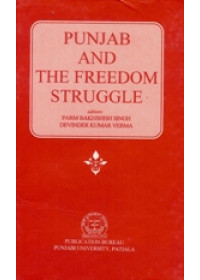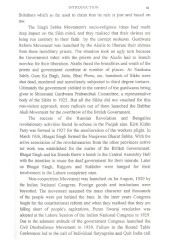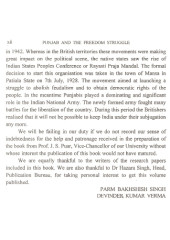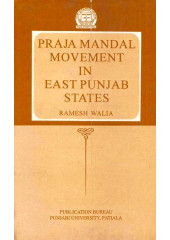Foreword To 'Punjab And The Freedom Struggle' By Parm Bakhshish Singh & Devinder Kumar Verma
Punjab has played a heroic role in the freedom struggle of the country. After the annexation of the Punjab, the brave people of this province waged a relentless fight against the British domination. A number of movements were started in the province for tthe overthrow of foreign yoke. Method and means adopted for this cause were varied. The option and choice for these were determined by the political outlook of the persons and organisations.If there were revolutionaries and terrorist groups operating for the overthrow of tthe government by violent means then there were other parties who professed that the goal of freedom can be achieved by non-violent means.
In this mass-upsurge almost all sections of the society played a significant role for the freedom of the motherland, right form the aristocracy down to the common poor man, almost all segments contributed to the noble cause of deliverence from the foreign rule. The sacrifices of the sons of the Punjab is unparalleled in the annals of the freedom struggle. No part of india suffered so much as the Punjab did, also perhaps no part of the country could have stood it so well and so successfully.
India is celebrating the fiftieth year of its independence. In this connection a number of programmes and projects were taken up for the celebrations. The Punjabi University, Patiala has also chalked out a number of plans to commemorate this great event in a befitting manner. A number of publications were planned on this occassion, for paying appropriate tribute to the sacrifices of great heroes and martyrs, who had suffered abundantly during the phase of national liberation. The volume in hand is one in the series. I am glad that this book contains the research papers which covers major portion of history covering the freedom movement. Editors of this book Parm Bakhshish Singh and Devinder Kumar Verma had taken great pains to collect, sift and to edit the matter.
I think the book in hand will be a valuable addition to the literature on the freedom movement of Punjab.
Introduction To 'Punjab And The Freedom Struggle' By Parm Bakhshish Singh & Devinder Kumar Verma
Being situated on the North-West of India, Punjab had always been a witness to continuous inroads of invaders. Fom earliest times the land of five rivers had become the arena where countless wars, battles and skirmishes took place and the sons of the soil defended their motherland by taking up cudgels against the foreign hordes. There was incessant struggle against the foreign agressors who wanted to establish their foodhold in the Punjab. In this state of tumoil and instablity waves after waves of foreigners poured into the Punjab throughout the history for making final assault on the Indian heartland. This made the Punjabis alert and strenuous, hard and heroic, enduring and adjustable. Spending their lives among the constant strife and struggle, having sword in hand they faced the dangers, hardships and trials bravely and with smile. All this made the Punjabi spirit indomitable. Subjugation, slavery and bowing to the agressors and tyrants was unacceptable to the people of the land. This glorious saga of patriotism, courage and bravery was written with the blood of its martyrs. They played their role of sentinels of national freedom, torch bearers of cultural standards and preserver of heroic tradition with examplary courage.
After many centuries of repression, tyranny and gloom Guru Nanak shook the Indian people from their deep slumber. He protested and criticised is no unequivocal terms, the invader Babur's unlashed terror and plunder. Guru Nanak was perhaps the first religious perceptor in India who had raised the voice against political injustice and repression. All other saints and bhagats restrained themselves to pointing out social injustice, religious bigotry and ritualism. After Guru Nanak the fifth master, Guru Arjan Dev and ninth master, Guru Teg Bahadur sacrificed their lives by upholding the values of truth and justice. Not scumbbing to the political pressure and injustice they became martyrs at the alter of God. The tenth master, Guru Gobind Singh raised the spirit born people in the form of Khalsa. The twice born, saint-soldiers were made immortal by the baptism of the double edged sword, Khanda. He taught his disciples to lead life of fearlessness, self respect and high moral values. Inspired and indoctrined by him, Banda Singh Bahadur launched upon an armed offensive against the Mughals and succeeded in freeing the entire eastern and southern Punjab, although for a short span. The history of mid-eighteenth century Punjab is full of horrowing tales of the sacrifices of valiant Sikhs. Empire's ruthlessness and vendetta was not confined to the leaders, but common men, women and children were also hunted down like a game from homes and shelters. History is witness that during the darkest period of their history not even a single Sikh came forward to seek pardon and swerved from the path of sacrifice. These gallant sons of the Punjab on the one hand were fighting the ruthlessness of the Mughal Empire and on the other leading a crusade against the challenge of Ahmed Shah Durrani, the Afghan invader. They were at last successful in pushing back the latter beyond Indus and making the western frontier free from the invaders for all times to come.
The success in the battle of Sirhind for the first time paved the way for the freedom to the people of this land, and established their self rule, after many centuries of subjugation. After the collapse of the Mughal Empire Maharaja Ranjit Singh emerged as the sovereign Sikh ruler of the Punjab. The Sikh Kingdom established by him could not last long. The land of five rivers was destined to enjoy the freedom for only a brief spell of fifty years. Lack of institutional infrastructure, internal conflicts and treachery gave way to the British design, and the Kingdom was annexed to the East India Company's territories in 1849.
Immediately after the First Anglo Sikh War it was realised by the patriotic leaders in the Lahore Durbar Army that the day is not far off when the Company's standard will be unfurled on the ramparts of the Lahore Fort. Whereas Sardar Sham Singh, Chattar Singh, Sher Singh and Diwan Mul Raj of Multan were planning to check the foreigners inroad militarily, Bhai Maharaja Singh made extensive tours in the Doaba and Majha areas of the Punjab and gathered round thousands of people around him. He was considered a holy man by the Sikhs, Hindus and Muslims, while leading compaign against the foreigners. Although Bhai Maharaja Singh's efforts ended with the abortive discloser of Prema Conspiracy Case, yet he was able to enthuse the spirit of courage and liberty among the masses.
The revolt of 1857 found its echo in the Punjab also. In number of cantonments the soldiers revolted and were disarmed. Britishers found the conditions in Punjab extremely dangerous. The whole of the Southern Punjab was in revolt and sporadic attempts were made at many places for uprising. But the timely actions of John Lawrence to disarm Indian troops and other measures helped the Britishers in avoiding trouble in this sensitive province. When the Britishers were busy in taking stock of the political situation and aftermath of the revolt of 1857, there appeared another saint Baba Ram Singh, on the scene of Punjab who stirred the soul of the people, who belonged to Bhaini and was the disciple of Baba Balak Singh of Hazro. He was deeply moved by the despondency and lethargy set in the spirit of the Sikhs after the annexation. He had served in the Lahore Durbar army which he later on left in the year 1845. After the annexation of the Punjab Christian missionaries work in the field of conversion and cow-slaughter deeply disturbed Baba Ram Singh and the natives. In 1857 he started organising his followers in the Sant Khalsa fraternity which was struggling against the social and political evils. He enjoined upon his followers to lead pure and clean lives, avoid eating meat and to discard such social customs as female infanticide, child marriage, etc. Popularity of the movement soon brought it into confrontation with the British. Seventy five Kukas were blown off from the mouths of the cannons and Baba Ram Singh,their leader, was deported to Rangoon. Although Kuka's attempt to assertion was not successful yet it made deep impact on the minds of people and influenced the subsequent events in the freedom movement.
Later half of the nineteenth century in which many socio-religious movements started in the Punjab some of which had political overtones. Singh Sabha, Dev Samaj, Brahmo Samaj, Arya Samaj and Wahabi movements were launched to meet the challenge of christian missionaries. These on the one hand tried to safeguard their communities from the threat of conversion and on the other tried to improve the conditions of their brothers in the field of education through which they aspired to effect social and religious reforms. These movements provided a strong national, emotional and cultural base to counter the foreign influences. As a result of this a powerful middle class emerged in the Punjab which latter on became the vanguard of freedom struggle.
In the first decade of the twentieth century peasent unrest surfaced on the Punjab due to rural indebtdness and other faulty government policies. Passing of Land Act of 1901, increase of irrigation rates in the canal colonies and curtailing the rights of the cultivators resulted into agrarian agitation. In this political format Lala Lajpat Rai and Sardar Ajit Singh played a conspicuous role. A number of societies were formed and voluminous revolutionary literature was produced for inculcating nationalist spirit during this period. The organisers of this movements were successful in the sense that the colonisation Bill did not became an Act.
National awakening against the foreign domination was not restricted to the geographical boundry of India alone. The Punjabis living abroad working in far off countries like USA, Canada, England etc, were surprised to find disparities existing in these countries and their motherland. In 1913 the Ghadar Party was formed under the banner of the Hindustan workers of the Pacific Coast with Baba Sohan Singh Bhakna as its president and Hardyal as its Secretary. In 1914 Baba Gurdit Singh an enterprising man hired Japanese steamer Kamagata Maru to take 376 people to Canada directly. The passengers were denied landing at Vancouver and it was forced to return back to India. At Budge Budge Harbour at Calcutta due to conflict with police18 persons were killed and 25 were wounded. The Ghadar movement's plans come to the notice of the government and the grand plan of revolt and overthrow of the British Government ultimately failed due to the repressive measures.
As the Britishers faced tough opposition and resistance for their brutal rule, they tried to enact draconian laws to quell the people's awakening. Rowlatt Bill was Such measure, against whch nation wide condemnation and opposition was organised through protest rallies and meetings. It was one such meeting at Jallianwala Bagh Amritsar, where General Dyer massacred about four hundred people on 13 th April, 1919. This carnage shook the whole nation and throughly exposed the Britishers which so far used to claim that its rule is just and based on law.
The Singh Sabha Movements's socio-religious ideas had made deep impact on the Sikh mind, and they realised that their shrines are being run contrary to their faith by the corrupt mahants. Gurdwara Reform Movement was launched by the Akalis to liberate their shrines from those hereditary priests. The situation took an ugly turn because the Government sided with the priests and the Akalis had to launch morchas for their liberation. Akalis faced the brutalities and wrath of the priests and government combine at number of places. At Nankana Sahib, Guru Ka Bagh, Jaito, Bhai Pheru, etc. hundreds of Sikhs were shot dead, murdered and mercilessly subjected to third degree tortures. Ultimately the government yielded to the control of the gurdwaras being given to Shiromani Gurdwara Prabandhak Committee, a representative body of the Sikhs in 1925. But all the Sikhs did not vouched for this non-violent approach, more radicals out of them launched the Babbar Akali Movement for the overthrow of the British Government.
The success of the Russian Revolution and Bengalies revolutionary activities found its echoes in the Punjab also. Kirti Kisan Party was formed in 1927 for the amelioration of the workers plight. In March 1926, Bhagat Singh formed the Naujawan Bharat Sabha. With the active association of the revolutionaries from the other provinces active net work was established for the ouster of the British Government. Bhagat Singh and his friends threw a bomb in the Central Assembly Hall with the intention to rouse the deaf government for their misrule. Later on Bhagat Singh, Rajguru and Sukhdev were hanged for their involvement in the Lahore conspiracy case.
Non-cooperation Movement was launched on 1st August, 1920 by the Indian National Congress. Foreign goods and institutions were boycotted. The movement assumed the mass character and thousands of the people were put behind the bars. In the later years Congress fought for the constitutional reform and when they realised that they are falling short of people's aspirations, Puran Swaraj resolution was adopted at the Lahore Session of the Indian National Congress in 1929. Due to the adamant attitude of the government Congress launched the Civil Disobedience Movement in 1930. Failure in the Round Table Conference led to the call of individual Satyagraha and Quit India call in 1942. Whereas the British territories these movements were making great impact on the political scene, the native states saw the rise of Indian States Peoples Conference or Rayasti Praja Mandal. The formal decision to start this organisation was taen in the town of Mansa in Patiala State on 7th July, 1928. The movement aimed at launching a struggle to abolish feudalism and to obtain democratic rights of the people. In the meantime Punjabis played adominating and significant role in the Indian National Army. The newly formed army fought many battles for the liberation of the country. During this period the Britishers realised that it will not be possible to keep India under their subjugation any more.
We will be failing in our duty if we do not record our sense of indebtedness for the help and patronage received in the preparation of the book from Prof J.S. Puar, Vice-Chancellor of our University without whose interest the publication of this book would not have matured.
We are equally thankful to the writers of the research papers included in this book. We are also thankful to Dr Hazara Singh, Head, Publication Bureau, for taking personal interest to get this volume published.
Table Of Contents For 'Punjab And The Freedom Struggle' By Parm Bakhshish Singh & Devinder Kumar Verma
| FOREWORD |
|
(V) |
| INTRODUCTION |
|
(VII) |
|
THE PUNJAB'S STRUGGLE FOR FREEDOM
THROUGH THE AGES
|
Ganda Singh |
1 |
|
A BRIEF ACCOUNT ON THE FREEDOM
MOVEMENT IN THE PUNJAB
|
FAUJA SINGH |
9 |
|
BHAI MAHARAJA SINGH AND HIS ROLE IN THE
FREEDOM STRUGGLE
|
M. L. Ahluwalia |
51 |
|
LAST PHASE OF MAHARAJA DULEEP SINGH'S
LIFE
|
Ganda Singh |
63 |
|
ROLE OF THE SIKHS IN THE REVOLT OF 1857
IN PUNJAB
|
S. K. Bajaj |
77 |
|
THE KUKAS-A MILLENARIAN SECT OF THE
PUNJAB
|
W. H. McLeod |
85 |
|
PUNJABI PARTICIPATION IN THE INDIAN
NATIONAL CONGRESS (1885-1905)
|
Ganeshi Mahajan |
114 |
|
THE PUNJAB DISTURBANCES OF 1907 :
THE RESPONSE OF THE BRITISH GOVERNMENT
IN INDIA TO AGRARIAN UNREST
|
N. Gerald Barrier |
124 |
| LALA LAJPAT RAI |
Ganda Singh |
161 |
|
SARDAR AJIT SINGH-AN EARLY INDIAN
REVOLUTIONARY
|
Joginder Singh Dhanki |
170 |
|
GHADAR SOURCE : RESEARCH ON PUNJABI
REVOLUTIONARIES IN AMERICA
|
Mark Juergensmeyer |
182 |
|
ANATOMY OF THE EARLY PHASE OF PUNJAB
DISTURBANCES 1919
|
S. D. Pradhan |
204 |
| JALLIANWALA BAGH |
K. L. Tuteja |
215 |














